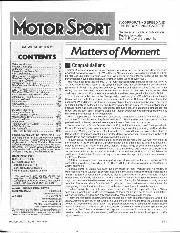
Matters of moment, November 1986
Congratulations This is the time of year when championships are wound up, new cars are launched and prizes are awarded. As we went to press, the World Drivers' Championship was…
Amid the excitement of a new Formula 1 season getting under way, and buried beneath detailed explanations of aero management on websites, was the announcement of a brand new racing series. Extreme H is set to become the first hydrogen championship when it launches in 2024 and, it is hoped, will drive innovation in hydrogen engine technology.
The championship would run alongside Extreme E, the electric off-road series that had its debut season in 2021 and which attracted high-profile teams including those formed by Lewis Hamilton, Nico Rosberg and Chip Ganassi Racing. It would race in the same locations, on the same days with the same format and would also use Extreme E’s back-office kit like the St Helena, the refurbished ship which transports all the cars and equipment and acts as a kind of mobile lab calculating the environmental impact of each race. Like Extreme E, the hydrogen series would presumably claim to be raising eco awareness by racing in locations negatively affected by climate change.
And like Extreme E the new series is the brainchild of serial innovator Alejandro Agag. Announcing the launch last month he explained: “It has become increasingly clear to us that a hydrogen racing series is a natural evolution of our mission to showcase the possibilities of new technologies in the race to fight climate issues.
“Sport is the fastest and most effective platform for driving innovation, and by using the existing Extreme E platform we can also utilise our transport, talent and operations to ensure we minimise our footprint.”
It’s easy to be cynical about Agag. Here is a man who can’t seem to see a mode of transport without announcing an eco-racing series of it – the last one was an electric powerboat championship, E1, revealed in 2020 and due to start later this year. But I can’t help feeling a grudging admiration for him.
It was Agag who conceived and launched Formula E against the odds back in 2014, and despite the naysayers the series is now in its eighth season. Yes, many manufacturers have walked away – not least because they appear to have reached the limit of what they can usefully learn about electrical development within its regulations – but there’s no doubt the series legitimised battery-powered racing. Remember, back in 2014 electrification was still a debatable aim with the motor industry. Today it is a racing certainty.
Rule makers want to see hydrogen cars race for outright victory at Le Mans
Agag’s timing with hydrogen might be similarly prescient because after years in the doldrums the idea is again gaining traction. January saw the unveiling of the latest iteration of a hydrogen fuel cell racing car – the Forze IX. The project is being run by a team from the Dutch Delft University of Technology who have been refining fuel cell cars for 15 years and are now attracting interest from significant players from technology and industry, including Hyundai and the project’s principal partner, Shell. Previous versions of it have competed and won against ICE cars, and the team is aiming for a spot at Le Mans.
Meanwhile, the MissionH24 hydrogen race car developed jointly between the ACO and GreenGT has been out testing ahead of its planned running in the Le Mans Cup this year. The project now has technical backing from Red Bull Advanced Engineering and Oreca with the aim of competing in a new hydrogen category at Le Mans in 2025. Rule makers have said that ultimately they want to see hydrogen cars race for outright victory against the Le Mans Hypercar class.
Of course, you could dismiss these ripples in the racing pond as mere gimmicks. And the old adage about hydrogen being the fuel of the future – and always will be – still feels true. But that would risk downplaying the brilliant innovative minds motor racing attracts. This was brought home to me recently when reading a new book called Racing Green: How Motorsport Science Can Save the World. In it, author Kit Chapman examines the myriad innovations and scientific advances that began in motor racing but have benefited wider society.
He details such tech transfers as Williams’s energy recovery flywheel system that was used by Audi to win Le Mans 2012, which is also used in London buses to reduce emissions by 20%; examines how competition is driving battery technology; and tells the brilliant story of how F1 teams came to the aid of the health service during the pandemic with their unique set of skills and can-do attitude (such a good tale that we republish it in this month’s issue on p130).
As Chapman writes: “[Motor racing] is so much more than cars going around in circles. I see the world’s fastest R&D lab. It’s a place where we are reminded that the word engineer doesn’t come from someone who maintains engines; it’s from the Latin igenium, meaning cleverness.”
All of which reminds me of an interview with Nick Wirth, former Benetton man and founder of Wirth Research, an R&D firm. “History will say that the gift motor sport really gave the world in the 21st century was not flappy gear-change paddles and ceramic brakes,” he said. “The real gift is high-technology tools developed in the fire of motor sport competition, where if it works you win and if it doesn’t you die; tools and technologies that are solving real-world problems. That is how motor sport will be remembered in the future.”
On the eve of what promises to be another epic season of racing, that seems a suitably important and optimistic message to broadcast.
Joe Dunn, editor
Follow Joe on Twitter @joedunn90